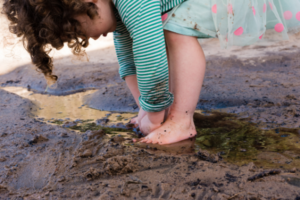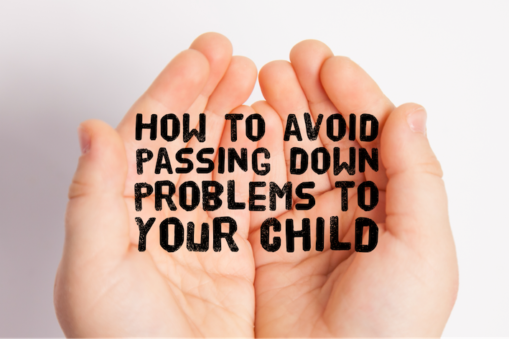Before becoming a parent, I thought about all the things that I wanted to pass down to my children. You know… all the values, skills, habits and wisdom I thought would set them up for success in their lives.
Most of us do that sort of thing, right?
There are all these questions we get to ask ourselves about what we want to overtly teach our children. Do I want them to learn about phonemes? The life cycle? Or social etiquette? Do I want to focus on helping them build problem-solving skills? Emotional regulation skills? Or positive self-talk?
These are just some of the choices I can make when it comes to teaching my children.
But what I didn’t spend a lot of time considering before my kids were born were all the things I didn’t want to pass on. I’m talking about all the things about me that hinder, harm, complicate, or otherwise get in my way.
Because there are all these things that I do without any conscious thought, outside of the moments when I’m intending to teach, where my children are still learning from me. It’s the times when it’s just me reacting to the world around me. And they are watching.
Things like my steadily rising stress level when my kids get messy. Or the way I retreat when animals approach me (despite growing up on a farm… I don’t know what happened there). Or my tendency towards self-doubt.

If given the choice, these are things I would avoid passing down to my children. But if I freely admit our children learn by watching, does that mean we are doomed to pass on our flaws to our children?
The happy answer is NO!
“But how?” you ask. There are two avenues to interrupting the transmission of these negative habits: exposing your child to people who do things differently and narrating your process towards change.
Expose your children to different ways of being
One mechanism of interrupting that transmission of negative habits to your children is by exposing them to others who do those things differently. That means intentionally seeking out people who DON’T exhibit the same flaws as you.
For me, that means intentionally seeking out people to spend time with my kids who embrace mess, love animals, and exhibit self-confidence.
You see, children are like sponges and they tend to soak up information about how you’re supposed to act, think, and feel based on what they see around them. So if I’m the only person they spend time with, they are going to receive the message that mess is bad, animals are gross or scary, and people are not supposed to be kind to themselves. Eek. That is not something I want to give them.
If you’re in a marriage or partnership in which the other person offers a healthier perspective on those things you struggle with, well, then it’s going to be a lot easier. Because they are going to see that healthier approach to life in the everyday moments of family life.
My husband, as an example, has the self-confidence part down. As a result my kids get to regularly observe how he approaches new situations believing in his own ability and taking on new challenges with motivation instead of fear. He is also there to readily pump up my kids with messages of confidence as they face new things, and that confidence they feel from him seeps down into their own perceptions of themselves. This is all good!

But if your partner shares your same struggles (as mine does with the mess and animal situations), then you’re going to want to seek out others who don’t. For us, this is where our adored babysitter comes into play. She invites the kids to make mud pies, baking soda volcanoes, and hand-painted masterpieces whenever she’s with them. That means several hours each week, my kids get to engage in messy, dirty, fun-loving play, and this is so, so good for them! And they get to do it without my anxiety getting in their way and stressing out their experience.
A similar experience happens with our babysitter demonstrating love for animals just by allowing the children to watch how she approaches passing pets — lovingly and calmly. Each time she does so, it helps strengthen the little pathway in their brains that connects animals with joy.
By being exposed to someone who doesn’t have the same hangups, they realize that there are actually multiple ways of seeing the world. The associations I have with mess, pets, and self-doubt are no longer taken as fact. They are able to realize that their Mama sees it one way, but their beloved babysitter sees it another. Both are valid, and this gives my children the opportunity to have choice in how they want to react.
Narrate your process towards change
While involving other people in your children’s life that have some healthier perspectives can help a lot, you also have a role to play. And that is to work on your issues and narrate your process to your kids when you can.
Let me explain.
I know that I struggle with messiness. When I see my kids get out their shovels and start to “garden,” or when they suggest we paint today, or even when they offer to “help” make my morning smoothie, my stress level rises. My automatic thoughts here tend to be, “this is going to be a disaster,” “I don’t have the energy to deal with that,” or some other variation of the same.
But I am fully aware that sending the overarching message “MESS IS BAD” can be really harmful to my kids. Because kids need the freedom to explore and experience mess, without fear of repercussions.

If I allow my own anxiety about the mess to dictate, then I will deprive my children of this important developmental experience, and will likely pass on this mentality “mess is bad” to them. So I need to work on my own issues.
This means intentionally doing things I don’t necessarily want to do, and tolerating the discomfort that arises in me when we do them. It’s ok to start small, as long as you start.
Inevitably there will be times when I don’t handle it so well. And this is where the narrating part comes on. Let’s say that I agree to do a painting project, but my stress level reaches capacity and I lose my cool when one child spills the paint. My kids may take from that they did something wrong, which is certainly not the case. My dislike for mess is not the same as they did wrong. So I have to correct that assumption in their minds.
Correcting the unhelpful assumptions that come from our own reactions can sound like an acknowledgment of our mistakes. It might go something like this:
“Mama got upset when you spilled your paint cup because I have a hard time with mess. But you didn’t do anything wrong. It’s ok to spill things and make messes. I’m working on teaching myself this.”
While spilling the paint cup with their babysitter probably would have been a less stressful experience for my kids, my acknowledgment of my stressed response helps them to see that the issue is mine (discomfort with mess) and not theirs (bad for making a mistake). It won’t necessarily make the immediate situation any more pleasant for them, but it’s helping them to prevent any long-term damaging messages from being internalized into their brains.
It does NOT have to be inevitable that your child will experience the same struggles as you, and now you have two approaches to help you intentionally offer them another perspective. I hope these help, and would love to hear how it worked for you!
QUICK LINKS:
When Your Magic Wand is Broken
Why You Should Let Your Child Be Disappointed
___
Dana Basu, PsyD is a licensed clinical psychologist at EverGROW therapy and founder of Everything But Crazy, an online resource for parents. She provides individual therapy, support groups, and online resources for parents in Orange County and throughout the state of California via online therapy. She specializes in working with the highly sensitive person and people with difficult childhood experiences, trauma, parenting stress, and chronic guilt.


